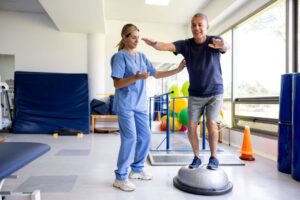As we transition our loved ones to a nursing home, we grapple with the question; “How can we ensure they continue to live a fulfilled and vibrant life?” People often associate nursing homes with the decline of the quality of life – but it doesn’t have to be so. Contrary to popular assumption, a golden age lifestyle can be laced with vibrancy, enthusiasm, and overall improvement in well-being. In this blog post, we shift focus from not just prolonging life but enhancing its quality in a nursing home setting using proven strategies and practical tips. It’s more than companionship and routine medical care; it’s about redefining the aging experience. Dive in with us as we explore how you can turn your loved one’s golden years into their happiest yet at Four Seasons Health Care Solutions – a leading nursing home in Brooklyn.
There are several ways to enhance the quality of life for those staying in a nursing home. These can include maintaining social connections, participating in enjoyable activities such as hobbies or games, ensuring physical comfort and mental well-being, access to medical care, and personalized care plans that align with individual needs. Additionally, involving family members in the care process and maintaining open communication with staff can help ensure a positive experience for all parties involved.
Essential Healthcare in Nursing Homes
Providing essential healthcare in nursing homes is a fundamental aspect of enhancing the quality of life for residents. These facilities serve as homes to individuals who require specialized care due to physical or cognitive limitations. It is essential to ensure that they receive the necessary medical attention, medication management, and personal care support.
One crucial aspect of essential healthcare in nursing homes is continuous monitoring of residents’ health. Registered nurses, licensed practical nurses, and certified nursing assistants play vital roles in close observation and reporting any changes or concerns regarding residents’ health conditions. Regular assessments are conducted to detect any signs of infection, changes in vital signs, pain levels, or any other physical discomforts. Timely identification and prompt intervention can significantly improve residents’ overall well-being.
For instance, imagine an elderly resident with multiple chronic health conditions residing in a nursing home. Close monitoring by healthcare professionals enables early detection of any deteriorating health status, enabling timely medical interventions such as adjusting medications or initiating therapies to prevent further complications. This continuous support can help alleviate their suffering and maintain their optimal health.
Furthermore, medication management plays a critical role in ensuring the health and safety of nursing home residents. Residents often rely on multiple medications to manage various chronic conditions. It is essential for healthcare professionals to have a comprehensive understanding of each resident’s medication regimen, including dosage instructions, potential interactions, and possible side effects. Accurate administration of medications at the right time and correct dosages can prevent adverse reactions and promote residents’ overall well-being.
In addition to basic healthcare needs, it is important for nursing homes to prioritize personalized care plans for each resident. These care plans take into account individual preferences, needs, and goals. For example, if a resident requires assistance with activities of daily living (ADLs), such as bathing, dressing, or mobility support, creating personalized care plans helps ensure their specific needs are addressed. This personalized approach fosters a sense of dignity, respect, and autonomy for residents, allowing them to participate in decisions regarding their care.
Ensuring essential healthcare in nursing homes involves close collaboration among various healthcare professionals as well as open communication with residents and their families. It is vital for the staff to establish trusting relationships with residents and create an environment where they feel comfortable voicing their concerns or preferences. Effective communication allows for better coordination of care and provides reassurance to residents that their needs will be met.
Now that we have explored the importance of essential healthcare in nursing homes, let’s delve into another critical aspect: comprehensive medical and safety protocols.
Comprehensive Medical and Safety Protocols
Comprehensive medical and safety protocols are crucial in maintaining a safe and healthy environment within nursing homes. These protocols encompass a range of measures designed to prevent the spread of infections, ensure staff and resident safety, and provide quality healthcare services.
One essential component of such protocols is infection prevention and control. Nursing homes must implement stringent practices to minimize the risk of infectious diseases such as respiratory infections or gastrointestinal illnesses from spreading among residents. This includes regular hand hygiene practices, proper use of personal protective equipment (PPE), routine cleaning and disinfection of shared spaces, as well as strict adherence to isolation precautions when necessary.
In addition to infection control, emergency preparedness plans play a significant role in comprehensive medical and safety protocols. Nursing homes need robust plans in place to effectively respond to emergencies such as natural disasters or public health crises. These plans encompass procedures for evacuation, communication strategies, coordination with external emergency response agencies, and ensuring continuity of care for residents amidst challenging circumstances.
For instance, during times of extreme weather conditions like hurricanes or wildfires, effective emergency preparedness ensures that nursing home residents are evacuated in a safe manner, their medical needs are accounted for, and ongoing healthcare services are continued seamlessly. These well-coordinated efforts provide peace of mind to both residents and their families, knowing that their loved ones will receive the necessary care and support during challenging times.
Furthermore, comprehensive medical and safety protocols include resident and staff safety measures. Nursing home facilities should implement strategies to prevent falls, minimize medication errors, promote proper body mechanics when lifting or transferring residents, and maintain a safe physical environment. Regular training sessions for staff on safety procedures can help mitigate potential risks and keep everyone involved well-informed.
Robust medical and safety protocols at Four Seasons in Brooklyn ensure that our nursing home meets the highest standards in providing quality care while minimizing potential risks to residents and staff. By implementing these protocols consistently, nursing homes can create an environment where residents feel safe, cared for, and empowered to live a fulfilling life.
Managing Cognitive Decline
One of the key challenges in nursing homes is managing cognitive decline among residents. Conditions such as dementia and Alzheimer’s disease can significantly impact a person’s cognitive abilities, affecting their memory, thinking processes, and overall quality of life. As caregivers in nursing homes, it is crucial to implement strategies that not only support residents with cognitive decline but also enhance their well-being.
First and foremost, creating a structured and consistent environment can greatly benefit residents with cognitive decline. Establishing regular routines, such as set meal times and daily activities, can provide a sense of familiarity and stability. This structure helps individuals feel more secure and reduces confusion or agitation that may arise from unpredictability.
For instance, imagine a resident with dementia who is accustomed to having breakfast at 8 a.m. each morning. By ensuring that breakfast is served at the same time every day, you are providing a predictable routine that can help them feel more comfortable and anchored in their surroundings.
“Routines have been incredibly helpful in managing my mother’s cognitive decline. Knowing what to expect each day gives her a sense of security and helps minimize her anxiety.” – Jane, caregiver
A person-centered approach is also essential when managing cognitive decline. Each resident has unique preferences, interests, and abilities, which should be considered when designing care plans or engaging in activities. Taking the time to understand an individual’s background, hobbies, and past experiences can guide caregivers in tailoring activities that are meaningful and enjoyable for the resident.
Engaging individuals in meaningful activities can have remarkable benefits in managing cognitive decline. This may involve art therapy sessions, music programs, reminiscence therapy, or even simple tasks like gardening or baking. By tapping into their inherent abilities and interests, you can create opportunities for them to experience joy and a sense of fulfillment.
As crucial as managing cognitive decline is, optimizing the living conditions for nursing home residents also plays a significant role in enhancing their overall quality of life.
- Managing cognitive decline among nursing home residents can be challenging, but implementing a structured and consistent environment and a person-centered approach can greatly benefit their overall well-being. Engaging individuals in meaningful activities that align with their unique preferences, interests, and abilities can enhance their sense of purpose and accomplishment, social interaction, self-esteem, and joy. Optimizing living conditions is also essential for enhancing the quality of life for nursing home residents.
Optimizing Living Conditions for Residents
Creating a comfortable and stimulating living environment is paramount in ensuring the well-being and happiness of nursing home residents. There are several key aspects to consider when aiming to optimize living conditions.
Firstly, maintaining a clean and organized physical space is essential. A clutter-free environment promotes a sense of calmness and reduces any potential hazards for residents. Regular cleaning schedules should be implemented to uphold cleanliness standards, especially in shared spaces such as dining areas, common rooms, and bathrooms.
Imagine walking into a nursing home where the communal spaces are neat and tidy—the absence of clutter allows residents to navigate freely without obstacles or concerns of tripping or falling.
To further enhance living conditions, incorporating elements of comfort is vital. This includes providing comfortable furniture, adjustable beds, suitable lighting levels, and adequate heating or cooling according to each resident’s preferences. Individualized temperature controls within rooms can ensure that residents feel comfortable in their personal spaces.
Additionally, creating spaces that stimulate social interaction can greatly improve residents’ quality of life. Common areas should be designed with ample seating arrangements that encourage conversation and engagement. Incorporating features such as reading corners, game tables, or outdoor gardens can provide opportunities for socialization among residents and with visiting family members.
Some may argue that maintaining an optimal living condition might require substantial financial investment. While it is true that certain improvements may come with costs, prioritizing residents’ well-being should be a fundamental consideration for nursing homes. By investing in comfortable and stimulating living conditions, nursing homes can provide an environment that promotes positive experiences and overall satisfaction for residents.
Ultimately, by managing cognitive decline effectively and optimizing living conditions, nursing homes can significantly enhance the quality of life for their residents, promoting not only physical well-being but also emotional and social fulfillment.
Physical Comfort and Activities
Ensuring the physical comfort of nursing home residents is a crucial aspect of enhancing their overall quality of life. This involves creating an environment that prioritizes comfort, and safety and promotes engagement in meaningful activities.
To begin with, personalized care plans should be developed for each resident, taking into account their unique needs and preferences. This includes providing comfortable bedding, appropriate seating, and maintaining suitable room temperature. It is essential to regularly assess their immediate physical needs, such as pain management, medication administration, and mobility assistance.
Engaging residents in stimulating activities plays a significant role in promoting physical well-being and preventing feelings of isolation or loneliness. This can range from simple games and puzzles that encourage cognitive function to organized group exercises or gentle physical therapy sessions tailored to individual abilities.
Additionally, incorporating elements of nature into the facility’s design, such as indoor gardens or outdoor spaces for walking and relaxation, can contribute to a calming and therapeutic atmosphere. Access to natural light and views of greenery has been shown to positively impact mood and overall well-being.
It’s important to involve residents in decisions related to activities and encourage them to remain active at their own pace. Providing a variety of options that cater to different interests, such as arts and crafts classes, music therapy sessions, or even pet therapy can provide opportunities for socialization and emotional support.
Staff training is vital in understanding the unique needs of residents and implementing proper techniques for transferring, positioning, and assisting with daily activities while considering their comfort and dignity. Regular communication channels between staff members are crucial to ensure all aspects of resident care are addressed and consistency is maintained.
Remember, each individual has their own preferences, limitations, and abilities. By taking a person-centered approach to physical comfort and activities, nursing homes can create an environment that respects each resident’s unique needs, promotes engagement and socialization, and ultimately enhances their quality of life.
Now that we have explored the importance of physical comfort and activities in nursing homes, let us shift our focus to another crucial aspect: promoting independence among residents.
- According to a study conducted in 2023, the implementation of QOL.SRI/CP, a Quality Life Structured Resident Interview and Care Plan led to significant improvement in nursing home residents’ quality of life at both 90- and 180-day follow-ups.
- The same study found that those patients who were involved in activities related to the Eden Alternative model saw a reduction in boredom, loneliness, and helplessness – indicators connected directly to the quality of life.
- Another research points out that simple interventions such as offering snacks and assistance for improving caloric intake can improve the overall health status of nursing home residents significantly.
Promoting Independence Among Residents
Independence is a fundamental aspect of enhancing the quality of life for nursing home residents. It allows individuals to maintain a sense of control over their lives, make choices that align with their preferences, and participate in decision-making processes related to their daily routines and care.
To promote independence, it is essential for nursing homes to adopt a person-centered approach to care. This means acknowledging and embracing the uniqueness of each resident and tailoring support according to their specific needs and abilities. By involving residents in everyday decisions such as meal planning or choosing clothing options, they can maintain a sense of autonomy.
In addition to daily decision-making, engaging residents in larger decisions regarding facility policies, social activities, or community involvement empowers them further. Regular meetings or forums where residents can voice their opinions and contribute ideas foster a sense of ownership within the nursing home community.
Physical independence is equally important. Encouraging residents to take care of personal hygiene and dressing fosters a sense of self-care and autonomy. Simple modifications in living spaces, such as grab bars or ramps for wheelchair accessibility, can also enable residents’ mobility with minimal assistance.
Engaging residents in social activities both within and outside the nursing home setting can promote social connections and prevent isolation. Organizing outings to local events, visits to museums or parks, or even involving residents in community volunteer programs can provide a sense of purpose and independence.
By prioritizing individual needs, involving residents in decision-making, fostering physical independence, and promoting social engagement, Four Seasons Nursing Home creates an environment that empowers residents to live their lives with dignity and happily.
Techniques for Cognitive Ability Retention
Maintaining and enhancing cognitive abilities in nursing home residents is crucial for their overall well-being and quality of life. There are various techniques that can be implemented to help retain cognitive function and slow down cognitive decline. One effective technique is cognitive stimulation therapy, which involves engaging residents in activities that stimulate different cognitive domains such as memory, attention, and language skills. Examples of such activities include puzzles, word games, trivia quizzes, and reminiscence therapy.
Another approach is reminiscence therapy, which involves prompting residents to recall past events, share stories, or engage in discussions about specific topics from their personal history. This not only helps to preserve memories but also provides a sense of identity and purpose. Incorporating the use of familiar objects like photo albums or music from their era can further enhance the effectiveness of this therapy.
Additionally, music therapy has shown promise in improving cognitive function in nursing home residents. Listening to familiar songs or playing musical instruments can trigger memories and emotions, stimulating the brain’s neural connections. Music therapy can also have a calming effect on residents, reducing stress and anxiety.
It’s important to note that maintaining physical health is closely linked to cognitive function. Encouraging regular exercise tailored to the individual’s abilities can improve blood flow to the brain and promote neuroplasticity. Physical activities like chair exercises, walking programs, or even gardening can contribute to overall cognitive health.
By implementing these techniques, nursing homes can create an environment that promotes cognitive ability retention. It is essential to assess each resident’s unique needs when planning activities and involve them in the decision-making process. Customizing interventions to suit their interests, abilities, and preferences is crucial for their engagement and success.
Now that we have explored techniques for cognitive ability retention, let’s shift our focus to the importance of fostering positive social relationships in nursing home settings.
Fostering Positive Social Relationships
One of the key factors contributing to the quality of life for nursing home residents is the presence of positive social interactions and relationships. Feeling connected and engaged with others can significantly impact their emotional well-being and overall satisfaction with their living situation. Here are some strategies for fostering positive social relationships in nursing homes:
Promote communal dining experiences: Encouraging residents to eat meals together in a communal dining area can create opportunities for social interaction. This not only allows residents to bond over shared experiences but also provides a sense of belonging and camaraderie.
Organize group activities: Planning and organizing group activities based on residents’ interests can facilitate socialization. Activities such as art classes, book clubs, gardening groups, or game nights encourage residents to engage with one another, form friendships, and build meaningful connections.
Volunteer programs: Collaborating with local schools, organizations, or community groups to involve volunteers in nursing home activities can bring fresh perspectives and energy into the environment. Volunteers can assist with various tasks, including leading recreational activities or simply spending time conversing with residents.
Some may argue that technology-mediated communication could hinder real-life interactions among residents; however, when used appropriately, technology can actually enhance social relationships. For example, video calls with family members who live far away or using tablets to play interactive games together can help bridge physical distance and provide avenues for meaningful connections.
By actively focusing on nurturing positive social relationships within nursing home settings, residents can experience companionship, support, and a sense of community. These factors contribute significantly to their overall well-being and enhance their quality of life.
Facilitating Constructive Communication between Family and Care Staff
Communication between family members and care staff is essential for ensuring the well-being and quality of life of nursing home residents. Effective communication promotes mutual understanding, strengthens relationships, and fosters a collaborative approach to care. However, maintaining constructive communication can sometimes present challenges due to various factors such as emotional distress, differing expectations, or miscommunication. Therefore, it is vital to implement strategies that facilitate positive and effective conversations between family members and care staff.
One key strategy to facilitate constructive communication is establishing regular and open lines of dialogue. This involves creating opportunities for family members and care staff to connect, share updates, discuss concerns, and provide feedback. Regular family meetings or conferences can serve as platforms for information exchange and shared decision-making. These meetings can help foster a sense of transparency and trust among all parties involved. It allows family members to voice their concerns, ask questions, and gain a better understanding of their loved one’s care plan.
Another important aspect of facilitating constructive communication is active listening. Both family members and care staff should listen attentively to each other’s perspectives, concerns, and suggestions without interruption or judgment. By actively listening, individuals can gain a deeper understanding of each other’s viewpoints, leading to more effective problem-solving and decision-making.
Additionally, clear and concise communication is crucial for avoiding misunderstandings or confusion. Care staff should provide families with relevant information regarding their loved one’s care, such as medication changes, therapy updates, or any incidents that may have occurred. It is essential to use plain language and avoid medical jargon whenever possible to ensure that families fully comprehend the information being conveyed.
Ultimately, facilitating constructive communication between family members and care staff requires ongoing effort and commitment from all parties involved. By establishing regular lines of dialogue, actively listening, and practicing clear and concise communication, we can create an environment that promotes collaboration and enhances the quality of life for nursing home residents.
In conclusion, open and effective communication between family members and care staff is crucial for enhancing the quality of life for nursing home residents. By implementing strategies such as establishing regular lines of dialogue, active listening, and clear communication techniques, we can foster positive relationships and address concerns collaboratively. These efforts contribute not only to the well-being of residents but also to a sense of trust and partnership among family members and care staff. Together, we can create an environment that prioritizes the needs and desires of nursing home residents while providing them with compassionate and person-centered care.












